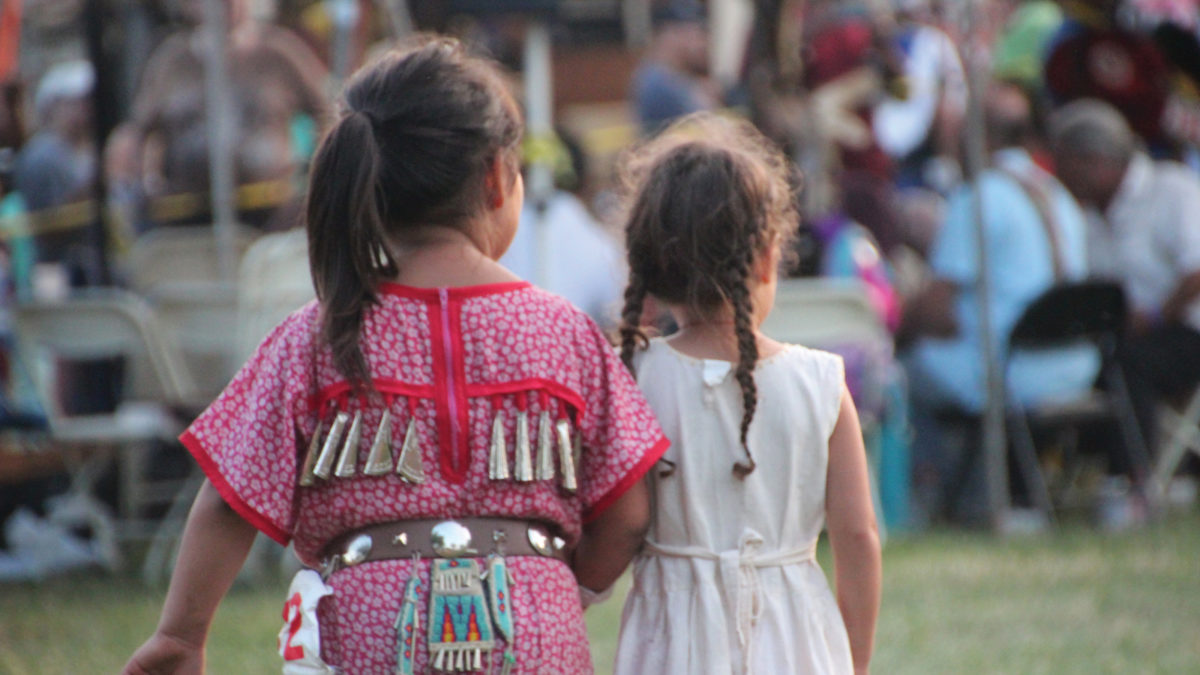
Reconciling Our Past
Longstanding Policy of Indian Child Separation Calls for Reparations for Native Americans
October 2021
Download This Article (.pdf)
On September 29, 2020, H.R. 8420 was introduced in Congress to establish the Truth and Healing Commission on Indian Boarding School Policy in the United States.1 The Act does not call for reparations for Native Americans, but it should. Perhaps the strongest argument for restitution derives from the formal US policy of child separation that was in effect for over 100 years.
1818: The Indian Civilization Act
Initially, the federal government attempted to eliminate tribal sovereignty with a policy of assimilation by choice. This policy was given a voice by James Monroe, who said in his 1818 State of the Union Address that “[t]o civilize them, and even to prevent their extinction, it seems indispensable that their independence as communities should cease, and that the control of the United States over them should be complete and undisputed.”2
Following Monroe’s lead, Congress adopted the Civilization Fund Act that same year.3 This Act provided Indian tribes with instruction in agriculture, reading, writing, and arithmetic, but only upon their consent. Congress appropriated $10,000 annually,4 which paid missionaries and church leaders to establish schools designed to replace tribal practices with “civilized” Christian culture.
Forced Removal from the East
By the time he left office in 1825, however, Monroe had changed his mind about assimilation by consent and advocated “forced removal” of tribes to west of the Mississippi.5 This led to the immediate relocation of the Red Stick Creeks in 1813. After losing the decisive battle at Horseshoe Bend, the Creeks were forced to cede more than 21 million acres of land to the United States. Andrew Jackson, who led the US Regulars and Tennessee militia, emerged from the war as a military hero and took it upon himself to meet several times with the North American “Five Civilized Tribes” to initiate what would eventually be called the removal policy.6
In 1824, Secretary of War John Calhoun established the Bureau of Indian Affairs (BIA) to oversee the fund and adopt programs to “civilize” the Native tribes. By the Act of July 9, 1832,7 the responsibility for educating Native Americans was placed under the Commissioner of Indian Affairs. At this point, the government created schools to train Native Americans in agriculture and established 87 boarding schools for Indian children. Throughout the 1830s and 1840s, the BIA engaged in further Indian removal.8
Several decades later, the Indian Appropriations Act of 1871 declared that Indigenous people were no longer considered members of “sovereign nations” and that the federal government could no longer establish treaties with them. Although the Act promised not to “invalidate or impair the obligation of previous treaties,” it was the first step toward the elimination of Indigenous sovereignty, which was completed in 1898 with the Curtis Act and by the invalidation of previous treaty obligations, a right that the Supreme Court granted to Congress in the 1903 decision Lone Wolf v. Hitchcock.9
1879: The Formal Child Separation Policy
In the 1870s, the federal government started to convert abandoned US Army posts and barracks to serve as the Indian boarding school system. These boarding schools generally were run in a military fashion and forced Indian children to speak only English. About one-third of the 357 known Indian boarding schools were managed by various Christian denominations.10
In 1879 the BIA authorized Richard Henry Pratt, a veteran frontier Indian fighter who once served with George Armstrong Custer, to establish the first off-reservation boarding school, the Carlisle Indian School in Carlisle, Pennsylvania. Pratt devised the school’s curriculum from his experiments on forced education on Cheyenne, Caddo, Arapaho, Kiowa, and Comanche prisoners of war at Fort Marion, Florida, in the early 1870s. The experiments impressed some members of Congress, who authorized the BIA to take control of the Carlisle Barracks to build the nation’s first off-reservation boarding school.11 As headmaster of the school for 25 years, Pratt had an unchallenged national dominance in determining Indian education.
Pratt explained his theory of Indian assimilation:
The most effectual way of getting civilization into the Indian is to get Indian into civilization. . . . Kill the Indian in him, and save the man. . . . It is a great mistake to think that the Indian is born an inevitable savage. . . . Transfer the savage-born infant to the surroundings of civilization, and he will grow to possess a civilized language and habit. . . .”12
As part of the first class of students, BIA Commissioner Ezra Hunt ordered Pratt to take children from the Lakota Tribe because of their “hostile attitude toward the government.” Commissioner Hunt hoped to pressure the Lakota and other Western tribes into opening up millions of acres of treaty-protected territory for white settlement.13
Boarding School Conditions
The legacy of the boarding school era lives on as historical and intergenerational trauma.14 Most Native American children who went to the boarding schools were forcefully taken from their families. Subjects such as reading, writing, math, and history were all taught from the white point of view, and boys were taught to farm, while girls were all taught domestic work. Many children were malnourished and suffered physical, emotional, sexual, and spiritual abuse. Thousands of students perished at the boarding schools themselves, and officials sent thousands more home to die. Many schools had cemeteries onsite.15
Despite the terrible conditions, congressional appropriations increased during the 1880s, and over the next three decades the number of federally operated Indian schools rose from 160 to 383, including day, boarding, contract, and mission schools.16 Congress later passed the Snyder Act of 1921, which provided broad authorization for further Indian programs, including education. Despite the legislation, the conditions in the boarding schools remained “deplorable.”17 The Indian Reorganization Act of 1934 introduced the teaching of Indian history and culture in BIA schools for the first time. And in 1975, Congress passed the Indian Self-Determination and Education Assistance Act, which authorized tribes and tribal organizations to negotiate self-determination contracts with the BIA for tribal management of specific schools or dormitories. In the Act’s declaration of purpose section, Congress declared its commitment to the establishment of a meaningful Indian self-determination policy for education that would deter further perpetuation of federal bureaucratic domination of the programs.18 Yet neither Act resolved the problem of child separation.
Continued Separation through Termination of Parental Rights
After World War II, local and state officials continued the practice of Indian child separation. From 1958 until 1967, the BIA and the Child Welfare League of America encouraged the termination of parental rights and adoption of Native American children by non-native families through the Indian Adoption Program. In 1978, 25% to 35% of all Native children were removed from their homes.19 The Association on American Indian Affairs has reported that, by the early 1970s, one-quarter of Native children nationwide had been taken from their families and placed in foster care or adopted by non-native families. As one historian stated: “Every single Indigenous family in the post-World War II era lived with the threat of child removal.”20
The Indian Child Welfare Act of 1978
Various congressional hearings during the 1970s, including the 1974 Senate Oversight Hearings, revealed documentation of “wholesale removal” of Indian children from their families and tribes and was described by one witness as “the most tragic aspect of Indian life today.” Another testified that “[t]he risk for Indian children of being involuntarily separated from their parents was in many states up to one thousand times greater than for non-Indian children.” As a result of the congressional hearing, the Indian Child Welfare Act was adopted in 1978.
Despite passage of this landmark legislation, the federal government failed to meet its trust responsibility for educating Native children. The US Department of Education issued the Indian Nations at Risk Report in 1991, citing the failure of public schools to educate many Native children, the continuing loss of Indigenous languages and customs, and the failure to appropriately acknowledge and support tribes’ rights to exist as fully self-determined individuals and groups.21 A recent report by the US Government Accountability Office found ongoing problems with financial management, facilities, and staffing.22
Reconciliation Measures are Needed
Introduced on September 29, 2020, the Truth and Healing Commission on Indian Boarding School Policy Act, H.R. 8420, attempts to deal with the legacy of the forced removal of hundreds of thousands of Alaska Indian and American Native children. The Act notes that the adoption and foster care programs between 1941 and 1967 continued the cultural genocide and assimilation policies by separating as many as one-third of Native American children from their families, and it states that these programs require investigation.23 This is an important first step, but reconciliation must follow.
The core principle on reparations under international law was formulated by the Permanent Court of International Justice in the case Concerning the Factory at Chorzow: “reparation must, as far as possible, wipe out consequences of the illegal act and reestablish the situation which would, in all probability have existed if the act had not been committed.”24 Under the principle of proportionality, reparation should be proportional to the injury caused by the wrongful act. Reparations should exclusively be aimed at remedying the damage committed through the wrongful act and should not be conceived of as exemplary in nature.25
Canada’s reparation policy provides a model. Like the United States, Canada operated hundreds of Indian residential schools with separationist agendas. However, Canada adopted the Indian Residential Schools Settlement Agreement in 2007, formally apologizing to former boarding school students and paying reparations to survivors. In 2009, Canada created a truth and reconciliation commission, which began a multiyear process of collecting and listening to survivors’ stories and opened residential school records to survivors and families to ensure that the history and legacy of the schools was not forgotten.26 About 150,000 indigenous youth attended the Canadian residential schools from the 1880s until the 1990s, and $1.9 billion was set aside in the settlement for former residents of the schools. Of the estimated 80,000 eligible former students, 98% received payment by the end of December 2012, with a total of $1.6 billion approved for payment.27
The United States should follow Canada’s lead. There must be a multiyear process of collecting and listening to survivors’ stories to ensure that the history and legacy of the schools is not forgotten. The BIA must open its records and provide accurate and truthful information of the numbers and identity of the separated children. There must be access to the records of all the boarding schools, and funds must be appropriated. Only then can healing begin.
Notes
1. Truth and Healing Commission on Indian Boarding School Policy Act, H.R. 8420, 116th Cong. (2019–20).
2. Monroe, Second Annual Message (Dec. 1818), www.stateoftheunionhistory.com/2017/04/1818-james-monroe-indian-civilization.html.
3. Civilization Fund Act, Pub. L. No. 15-85, 3 Stat. 516, ch. 85.
4. Id. Although the legislation by its own terms required the consent of Native Americans to be “civilized” by exposure to the US educational system, it was apparent from the Republic’s beginning that most Native Americans would oppose the policy. See Canasatego (Canisteo), Onondaga Grand Sachem (c. 1690–1750), response to the Virginia Legislature at the Treaty of Lancaster, 1744 (cited by Hightower-Langston, The Native American World at 357 (John Wiley & Sons, Inc. 2003)).
5. Monroe, supra note 2.
6. Prucha, “Andrew Jackson’s Indian Policy: A Reassessment,” J. of Am. Hist., Vol. 56, No. 3 at 528 (Dec. 1969) (citing Jackson’s talk with Indian Chieftains on September 20, 1821). The Indian Removal Act of 1830 formally authorized President Jackson to purchase land from willing Indian tribes for their removal to unsettled land west of the Mississippi. The tribes resisted both in court and by armed struggle (the Black Hawk War, Creek-III-War, and Seminole War), but most were eventually forced by a vastly superior military power to sign treaties and depart their homelands. Hightower-Langston, supra note 4 at 378–79.
7. 25 USC § 2.
8. See Anderson, Sovereign Nations or Reservations? An Economic History of American Indians (Pac. Research Inst. for Pub. Policy 1995); Hightower-Langston, supra note 4 at 337–39.
9. Lone Wolf v. Hitchcock, 187 U.S. 553 (1903); Indian Appropriations Act, 41st Cong. (3d Sess. 1871). See also French, Legislating Indian Country: Significant Milestones in Transforming Tribalism (Peter Land 2007).
10. Pember, “Death by Civilization,” Atlantic (Mar. 8, 2019), https://www.theatlantic.com/education/archive/2019/03/traumatic-legacy-indian-boarding-schools/584293.
11. Estes and Choate, “Where are the Indigenous children who never came home?” Collaboration between The Intercept and High Country News (Sept. 25, 2018).
12. As explained in “Putting the Movement Back into Civil Rights Teaching,” the goal of Indian education from the 1880s through the 1920s was to assimilate Indian people into the melting pot of America by placing them in institutions where traditional ways could be replaced by those sanctioned by the government. US federal policy called for the removal of children from their families and generally enrollment in a government run boarding school. See Teaching for Change, www.civilrightsteaching.org.
13. Estes and Choate, supra note 11 at 5–6.
14. Kids Matter, Inc., Boarding Schools and the History of ICWA, https://kidsmatterinc.org/boarding-schools-and-the-history-of-iowa.
15. Students at Carlisle and the roughly 160 other boarding schools were susceptible to deadly infections like tuberculosis and the flu. During Carlisle’s operation between 1879 and 1918, over 200 children were buried in its cemetery. See History Stories, The Carlisle Indian School, https://www.history.com/news/how-the-boarding-schools-tried-to-kill-the-indian-through-assimilation. Additionally, anthropologist Genevieve Bell reported that 1,850 students deserted, many risking dangerous journeys to return home. Lomawaima et al., “Reconsidering Richard Henry Pratt: Cultural Genocide and Native Liberation in an Era of Racial Oppression,” 57 J. of American Indian Educ. 92 (Jan. 2018).
16. Collins, “Indian Boarding Schools,” The Oregon Encyclopedia, https://www.oregonencyclopedia.org/articles/indian-boarding-school.
17. Inst. for Gov’t Research, The Problem of Indian Administration at 29 (Johns Hopkins Press 1928).
18. 25 USC § 2501, Declaration of Policy, https:cornell.edu/uscode/text/25/2501 accessed 4/8/2021.
19. Byler, “The Destruction of American Indian Families,” Ass’n on American Indian Affairs, Inc. (1977). Byler also attributed the federal boarding school policy and dormitory programs with contributing to the destruction of Indian family and community life. He noted that the BIA 1971 school census listed 34,538 children in its institutional facilities rather than at home. That figure represented more than 17% of the Indian school-age population of federally recognized reservations and 60% of the children in BIA schools. On the Navajo reservation, 20,000 children (90% of the school age population) lived in boarding schools. See also Kids Matter, Inc. supra note 14; The Adoption History Project, “Indian Adoption Project,” https://pages.uoregon.edu/adoption/topics/IAP.html.
20. Estes and Choate, supra note 11 at 8.
21. US Dep’t of Education, “Indian Nations at Risk: An Educational Strategy for Action,” Final Report of the Indian Nations at Risk Task Force at iv, 2. (Oct. 1991).
22. Faircloth, “The Education of American Indian Students,” American Educator-American Federation of Teachers (winter 2020–21) (internal citations omitted), https://www.aft.org/ae/winter/2020-2021/faircloth_sb1.
23. H.R. 8420, supra note 1.
24. Concerning the Factory of Chorzow (Merits), Permanent Court of International Justice, Series A, No. 17, 1928 at 47.
25. See Draft Articles on Responsibility of States for Internationally Wrongful Acts, with commentaries, 2001, in Yearbook of the International Law Commission, 2001, vol. II, part 2, as corrected, at 26–30 (United Nations 2008), https://legal.un.org/ilc/texts/instruments/english/commentaries/9_6_2001.pdf.
26. Pember, supra note 10 at 9.
27. Marshall and Gallant, “Indian Residential Schools Settlement Agreement,” The Canadian Encyclopedia (July 11, 2013), https://www.thecanadianencyclopedia.ca/en/article/Indian-residential-schools-settlement-agreement.
The Association on American Indian Affairs has reported that, by the early 1970s, one-quarter of Native children nationwide had been taken from their families and placed in foster care or adopted by non-native families.


